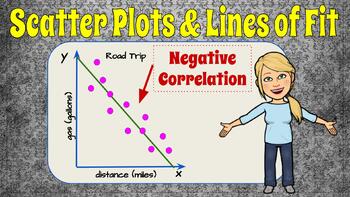Scatter Plots & Lines of Fit Lesson/Task Cards/Video
- Google Slides™

Description
You are purchasing an editable set of the Google Slides used to make this video. All slides are animated as seen in the video lesson. You may use these slides as a guided lesson, scaffolded class notes, print or share student practice slides as task cards, and/or adapt using Pear Deck for whole class instruction.
In this video lesson we will learn about the relationship between two data sets displayed in a a graph called a Scatter Plot. We will discover that a scatter plot display data represent two data sets to determine if there is a relationship. The relationship is referred to as correlation Correlation could be positive, negative or no correlation. The "trend" in the data could be linear or nonlinear. We will learn to draw a trend line that lies between the data points with as many data points above the line as below the line. We will use points on the line to write the equation of the line of fit. We will interpret the slope and y-intercept of the line and use the line to predict data not displayed on the graph. Student practice is embedded in the lesson with modeled exemplar solutions.


